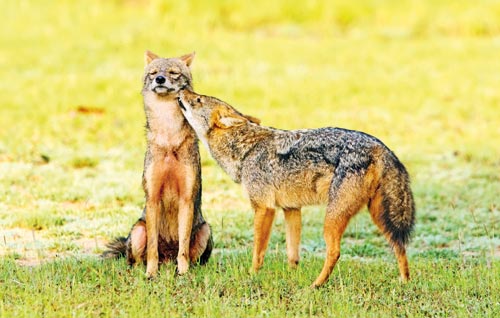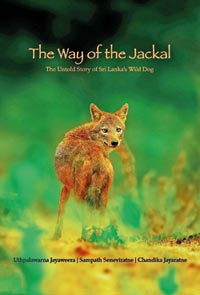Sri Lanka’s Jackal to finally get its day

Jackals are very social animals. Pic by Chandika Jayaratne
Sri Lankans are lovers of dogs. A close cousin of these human companions, of course, in the wild is much-maligned and portrayed as cunning and slinking around stealthily.
These are the “negative” characteristics which have also been brought to the fore in the political thriller ‘The Day of the Jackal’ based on the popular novel of the same name about a deadly assassin by English writer Frederick Forsyth.
In an about-turn, however, three Sri Lankans are on the cusp of shining a different and bright light on the humble nariya – the Sri Lankan jackal (Canis aureus naria).
Having gone into the wilderness across the country and been charmed by the howls of Sri Lanka’s one and only wild dog, authors and scientists, Uthpalawarna Jayaweera, Sampath Seneviratne and Chandika Jayaratne, are attempting to right the record and pull off the shadowy veil covering this creature.
Using a distant photograph of a jackal in poor light, with the punch line: “Is our understanding of this extraordinary animal as hazy as this image?” in their book titled ‘The Way of the Jackal’, they emphasise that it is ‘The Untold Story of Sri Lanka’s Wild Dog’.
All three authors from the Laboratory for Molecular Ecology and Evolution, Department of Zoology & Environment Sciences, University of Colombo have no hesitation in going public with their “agenda”.
“This book is an attempt to turn the tide for this largely forgotten cutie. Here we attempt to reinvent Sri Lanka’s jackal, give it a ‘facelift’, provide a true and fair valuation and lift its status as both a valuable entity for the tourism sector and as a keystone species for the community,” they state. (A keystone species is one that helps define an entire ecosystem.)
To the query by the Sunday Times, ‘Why, the jackal’, Prof. Sampath Seneviratne says that surveys from across the world have indicated that the big cats, pandas, grey wolves, elephants and penguins are considered among the ‘most’ charismatic animals. In Sri Lanka, wildlife enthusiasts and photographers as well as tourists zero-in on iconic carnivores such as the leopard and the sloth bear, leaving out in the cold the third largest of them which is the jackal.
“There are few photographs and not much research on this ‘hidden gem’,” he says, pointing out that the Sri Lankan jackals are also the “only” island jackal population which has evolved from the Golden Jackal.
The Sri Lankan jackal also occupies an important ‘middle’ strata (mesocarnivore) between the big and small carnivores. Their broad-spectrum of food includes rodents, birds and snakes, while they also relish fruits.
 On their forays into rural Sri Lanka, the authors had oft been told by farmers that agri-pests such as peafowl were rampant, causing them much losses due to a drastic reduction in jackal numbers. This had prompted a comprehensive study, which they believe is a first, between 2021 and 2023.
On their forays into rural Sri Lanka, the authors had oft been told by farmers that agri-pests such as peafowl were rampant, causing them much losses due to a drastic reduction in jackal numbers. This had prompted a comprehensive study, which they believe is a first, between 2021 and 2023.
It was then that they found an “alarming” drop in jackal numbers. The creatures mainly roam the mid-elevations of the Wet Zone including Horana, Kalutara, Matugama, Ratnapura, Galle, Deniyaya and Kegalle and the Dry Zone areas of Uda Walawe, Yala, Mahaweli floodplains and Wilpattu.
“We found them mostly in Protected Areas,” reiterates Prof. Seneviratne, warning against the dangers jackals faced due to habitat loss, pesticides and distemper spread by domestic and feral dogs. He lamented over an incident where in Milleniya, Horana, two humans and four cattle died of rabies and even though usually there is no human-jackal conflict, it led to a senseless revenge killing of 32 jackals in 2020-21.
Next Prof. Seneviratne turns the spotlight on the fact that jackals are very smart and highly social – they mate for life and family bonds are so strong that pups of an earlier litter help to look after those coming after them.
Jackals are also formidable predators like the leopard and scavengers in the delicate balance of the wilderness and also canny survivors able to adapt to most habitats. They are good social hunters in packs using “mediocre weapons” such as teeth and claws as well as their high intelligence, he says, also singing their praises as the noisiest vocalizers similar to the purple-faced langur. “They cackle and howl creating a wilderness song, leaving us wondering whether it is the swansong of the wild.”
The seven chapters of the 148-page ‘The Way of the Jackal’ interspersed with beautiful colour photographs deal with ‘The Jackal’s Kin’; ‘Nariya of the Rural Folk’; ‘Howl of the Sri Lankan Outback’; ‘Fading Paw Prints’; ‘Underrated Pest Controller’; ‘A Facelift for Our Jackal’; & ‘The Researcher in Mind’ supplemented by a List of References & A do-it-yourself tool kit for students and citizen scientists.
 Interestingly, while on the inside cover page both the Sinhala and Tamil names of the jackal are given, to grab the reader’s attention an excerpt about the creature by Kumaratunga Munidasa and a folk tale in Tamil and English about ‘The jackal and crow’ have also been included.
Interestingly, while on the inside cover page both the Sinhala and Tamil names of the jackal are given, to grab the reader’s attention an excerpt about the creature by Kumaratunga Munidasa and a folk tale in Tamil and English about ‘The jackal and crow’ have also been included.
In the foreword, internationally acclaimed biodiversity scientist Dr. Anthony J. Giordano says that he was fortunate to see a jackal during his first visit to the island country…….“slowly skulking down the road as it approached our jeep, parked to the side. It craned its head around, peering tentatively into the window as it slunk by, nose high in the air and balancing looks of opportunity and fear. It never stopped as it passed”.
He asks: What was different in Sri Lanka? Or was in fact, the Sri Lankan Jackal the thing that was different?
Dr. Giordano adds that they deserve our research attention and protection, lest they vanish one day from one protected area and then another. “This book is, therefore, a timely spotlight on Lanka’s only native canid species. I hope it does much to start a larger conversation that upends untested assumptions about what the country’s jackal is, or is not.”
Therefore, it is the ‘big picture’ of jackals that the authors want to unveil to promote them as magnets or tourist-pullers, farmers’ friends and also those inextricably linked to bringing about a balanced eco-system.
A major effort to “rebrand” the Sri Lankan jackal!
| The book | |
| ‘The Way of the Jackal – The Untold Story of Sri Lanka’s Wild Dog’ published by the Wildlife and Nature Protection Society (WNPS) of Sri Lanka will be launched on May 16 at the Nations Trust WNPS Monthly Lecture at the Jasmine Hall, BMICH, Colombo 7.The special pre-launch price is Rs. 5,000 per copy (for WNPS members) and Rs. 6,000 (for non-members), while the post-launch copy will be Rs. 7,500. The book will be available at Barefoot, Vijitha Yapa and Sarasavi Bookshops.
|
Searching for an ideal partner? Find your soul mate on Hitad.lk, Sri Lanka's favourite marriage proposals page. With Hitad.lk matrimonial advertisements you have access to thousands of ads from potential suitors who are looking for someone just like you.


